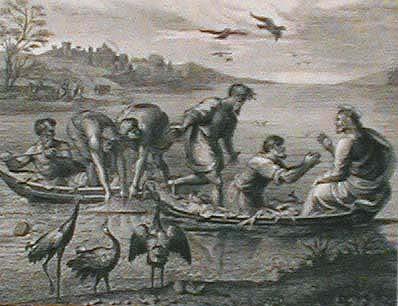
By Kind Permission of Leeds University Library

By Kind Permission of Leeds University Library
Ruskin 's concern here is the 'prolonged and thoughtful' labour of the 'great mind' of Raphael in his work on the 'sea colewort' ('sea-kale' is the more common name for crambe maritima in English) in the foreground. The plants exemplify 'realisation to the mind 'rather than 'deception of the eye' ( MP I:xxix), and provide authoritative examples of the careful attention which great artists paid to the natural phenomena of a divinely created world, realising nature rather than seeking to improve on it (see Ruskin on Raphael and Works, 9.407). The subject matter of the cartoon is taken from St. Luke V verses 1 - 10. The setting is the Lake of Gennesaret. After a night in which no fish were caught, Peter obeyed Christ's command to let down the net:
And when they had this done, they inclosed a great multitude of fishes: and their net brake. When Peter saw it, he fell down at Jesus' knees, saying, Depart from me; for I am a sinful man, O Lord... And Jesus said unto Simon [Peter] Fear not; from henceforth thou shalt catch men.
Ruskin is more critical in Modern Painters III; the 'impossibly small boats' are 'inexcusably absurd' ( Works, 5.393). Raphael was one of those who were 'too ignorant of landscape to understand or take advantage of the little he [ Masaccio ] had done' ( Works, 5.397). The background to both cartoons mentioned in this passage is described as 'flattish flakes of hill, nearly formless...; and thenceforward the Tuscan and Roman schools grew more artificial and lost themselves finally under round headed niches and Corinthian porticoes' ( Works, 5.397). The later account is not incompatible with what is said here in Modern Painters I, but there is a decided shift of emphasis (see Ruskin on Raphael).
Raffaello Santi 1483-1520
The Miraculous Draught of Fishes c.1515
Tempera on paper, 319x399cm
Provenance: Brussels, weaving workshop of Pieter van Aelst, 1516-19; workshop, Jan van Tiegen, c.1525; Brussels, 1573; Genoa, c.1580-1600; bt Prince Charles of Wales in Genoa, 1623; Mortlake, 1639; Whitehall, 1649; Somerset House, 1650-1; in pawn in London, 1685; Banqueting House, Whitehall, 1690; Hampton Court, 1697; Set up in former King's Gallery (then Cartoon Gallery, or Great Counil Chamber) at Hampton Court, 1699; transferred to Buckingham Palace, 1763; transferred to Windsor, 1787-8; moved to the King and Queen's Presence-Chambers at Windsor, 1792; transferred to Hampton Court, Cartoon Gallery, 1804; to the South Kensington (now Victoria and Albert) Museum, 1865
Further Comments: The V&A (Victoria and Albert Museum) was formerly called the South Kensington Museum; the 'Royal Presence Chambers' refers to the King and Queen's Presence Chambers; the Cartoon Gallery, etc, which was once the 'King's Gallery' is at Hampton Court.
Collection: Victoria & Albert Museum (on loan from Royal Collection)